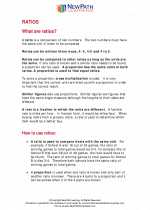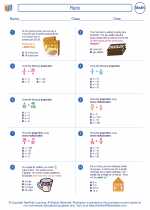Ratio: Explanation and Study Guide
A ratio is a comparison of two or more quantities. It is often written as a fraction or using a colon (:). For example, if you have 3 red marbles and 5 blue marbles, the ratio of red marbles to blue marbles can be written as 3:5 or 3/5. Ratios are used to compare the sizes of two or more quantities.
Writing Ratios
To write a ratio, simply compare two quantities using a colon or as a fraction. For example, if you have 4 apples and 6 oranges, the ratio of apples to oranges can be written as 4:6 or 4/6, which can be simplified to 2:3 by dividing both parts of the ratio by their greatest common factor.
Equivalent Ratios
Ratios that represent the same comparison are called equivalent ratios. Equivalent ratios can be found by multiplying or dividing both parts of the ratio by the same number. For example, the ratios 2:3 and 4:6 are equivalent because 2 * 2 = 4 and 3 * 2 = 6.
Ratio as a Fraction
Ratios can also be written as fractions. For example, a ratio of 2:3 can be written as the fraction 2/3. This is especially useful when solving problems involving ratios using fraction operations.
Using Ratios in Real Life
Ratios are used in many real-life situations, such as cooking (measuring ingredients), finance (calculating interest rates), and map reading (scale drawings). Understanding ratios is important for solving various problems in these areas.
Study Guide
When studying ratios, it's important to understand the following concepts:
- How to write ratios using a colon or as a fraction
- Finding equivalent ratios by multiplying or dividing both parts of the ratio
- Converting ratios to fractions and vice versa
- Applying ratios to real-life situations
Practice solving problems involving ratios and try to relate them to everyday situations to reinforce your understanding of the concept.
Remember that ratios are used to compare quantities and are an important aspect of mathematics and everyday life.
.



